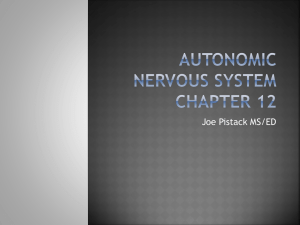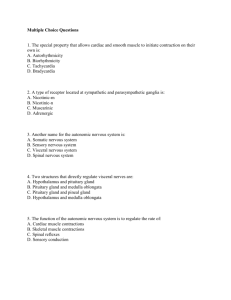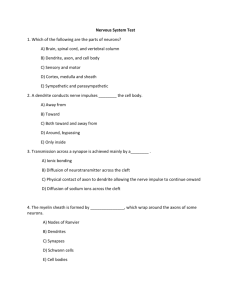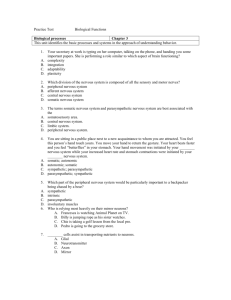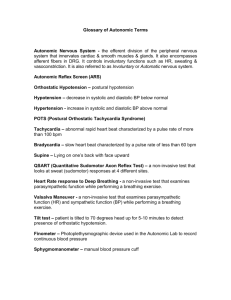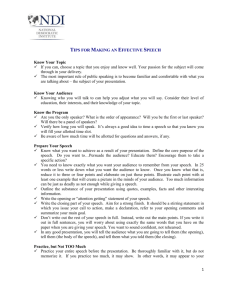Goals
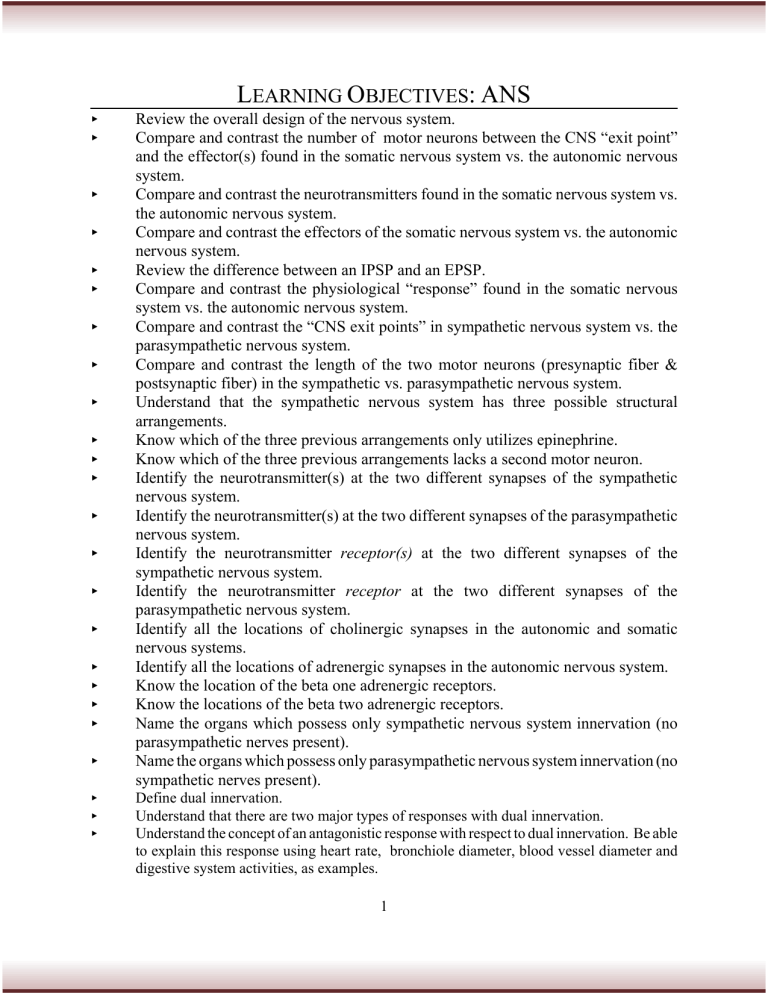
<
<
<
<
<
<
<
<
<
<
<
<
<
<
<
<
<
<
<
<
<
<
<
<
L
EARNING
O
BJECTIVES
: ANS
Review the overall design of the nervous system.
Compare and contrast the number of motor neurons between the CNS “exit point” and the effector(s) found in the somatic nervous system vs. the autonomic nervous system.
Compare and contrast the neurotransmitters found in the somatic nervous system vs.
the autonomic nervous system.
Compare and contrast the effectors of the somatic nervous system vs. the autonomic nervous system.
Review the difference between an IPSP and an EPSP.
Compare and contrast the physiological “response” found in the somatic nervous system vs. the autonomic nervous system.
Compare and contrast the “CNS exit points” in sympathetic nervous system vs. the parasympathetic nervous system.
Compare and contrast the length of the two motor neurons (presynaptic fiber & postsynaptic fiber) in the sympathetic vs. parasympathetic nervous system.
Understand that the sympathetic nervous system has three possible structural arrangements.
Know which of the three previous arrangements only utilizes epinephrine.
Know which of the three previous arrangements lacks a second motor neuron.
Identify the neurotransmitter(s) at the two different synapses of the sympathetic nervous system.
Identify the neurotransmitter(s) at the two different synapses of the parasympathetic nervous system.
Identify the neurotransmitter receptor(s) at the two different synapses of the sympathetic nervous system.
Identify the neurotransmitter receptor at the two different synapses of the parasympathetic nervous system.
Identify all the locations of cholinergic synapses in the autonomic and somatic nervous systems.
Identify all the locations of adrenergic synapses in the autonomic nervous system.
Know the location of the beta one adrenergic receptors.
Know the locations of the beta two adrenergic receptors.
Name the organs which possess only sympathetic nervous system innervation (no parasympathetic nerves present).
Name the organs which possess only parasympathetic nervous system innervation (no sympathetic nerves present).
Define dual innervation.
Understand that there are two major types of responses with dual innervation.
Understand the concept of an antagonistic response with respect to dual innervation. Be able to explain this response using heart rate, bronchiole diameter, blood vessel diameter and digestive system activities, as examples.
1
<
<
<
<
<
<
<
<
<
<
<
<
<
Define sympathetic tone. Name one organ that is under sympathetic “dominance” a.k.a. tone.
Define parasympathetic tone. Name one organ that is under parasympathetic “dominance” a.k.a. tone.
Understand the concept of a cooperative response with respect to dual innervation. Be able to explain this response using the male sexual response as an example.
Understand the three reasons why adrenergic synapses possess a more prolonged and more widespread effect.
Know all the information on nicotinic agonist medications.
Know all the information on the nicotinic antagonist medications.
Know the alternative name for nicotinic antagonist medications.
Know all the information on the muscarinic agonist medications.
Know the alternative name for the muscarinic agonist medications.
Know all the information on the adrenergic agonist medications.
Know the alternative name for the adrenergic agonist medications.
Know all the information on the adrenergic antagonist medications.
Know the alternative name for the adrenergic antagonist medications.
February 18, 2009 (10:40am)
C:\MyFiles\LCCC\a&p hybrid\learning_objectives_136\learning_objective_ANS_ch14.wpd
2

